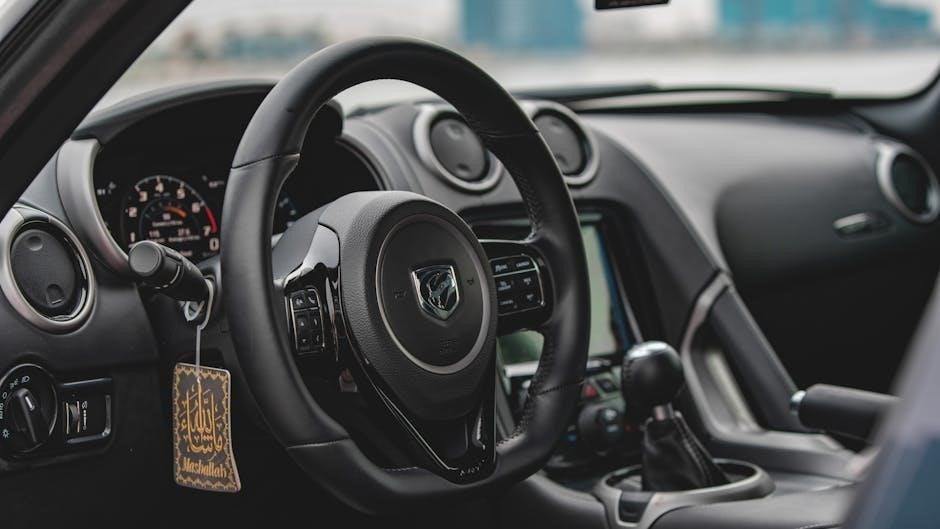evenflo car seat instruction manual
Evenflo offers a trusted range of car seats‚ including infant‚ convertible‚ and booster options‚ designed for safety and ease of use․ Proper installation and adherence to the instruction manual are crucial for ensuring your child’s safety while traveling․
1․1 About Evenflo
Evenflo is a trusted brand specializing in baby and children’s products‚ including car seats‚ strollers‚ and more․ Known for innovation and safety‚ Evenflo offers a wide range of car seats designed to meet the needs of parents and caregivers․ Their products undergo rigorous testing to ensure quality and reliability․ With a focus on convenience and safety‚ Evenflo car seats are popular for their ease of use and durability․ The brand provides comprehensive instruction manuals to guide parents through installation and usage‚ ensuring optimal safety for children․ Evenflo’s commitment to safety and customer satisfaction has made it a leading choice for families worldwide․
1․2 Overview of Evenflo Car Seat Models
Evenflo offers a diverse range of car seat models designed to accommodate children at various stages‚ from infancy to early childhood․ Popular models include the Symphony‚ Triumph Advance‚ and Tribute 5‚ each catering to different needs and preferences․ The Symphony model‚ for instance‚ is known for its all-in-one functionality‚ while the EveryFit and Revolve360 models emphasize ease of installation and versatility․ These seats are engineered with safety and convenience in mind‚ featuring advanced technologies like multi-block installation systems․ Evenflo car seats are available in convertible‚ infant‚ and booster styles‚ ensuring a secure fit for children as they grow․ Each model comes with detailed instruction manuals to guide parents through proper installation and usage‚ ensuring optimal safety and ease of use․
1․3 Key Safety Features
Evenflo car seats are designed with advanced safety features to protect children in various crash scenarios․ They undergo rigorous testing to meet or exceed federal safety standards‚ ensuring durability and reliability․ Many models include side-impact protection‚ which helps cushion the child during collisions․ The seats also feature a robust LATCH system for secure installation‚ reducing the risk of improper use․ Additionally‚ Evenflo incorporates energy-absorbing materials to minimize the force of impact on the child․ Some models‚ like the Revolve360‚ offer 360-degree rotation for easy access and multi-block installation systems for added stability․ The instruction manual plays a crucial role in highlighting these features and ensuring they are used correctly․ Evenflo’s commitment to safety is evident in their continuous innovation and adherence to strict testing protocols‚ making their car seats a trusted choice for parents․
Importance of the Instruction Manual
The instruction manual is essential for ensuring proper installation and safe use of Evenflo car seats‚ reducing the risk of serious injury or death for children․
2․1 Why the Manual is Crucial for Safety
The instruction manual is vital for ensuring the safe and correct use of Evenflo car seats․ It provides detailed guidance on installation‚ proper usage‚ and critical safety warnings․ By following the manual‚ parents can minimize risks of injury or death‚ as improper installation or misuse can lead to serious consequences․ The manual also includes model-specific instructions‚ ensuring compatibility with your vehicle and adherence to safety standards․ Ignoring the manual can result in improper securing of the child‚ inadequate protection‚ and potential failure in crash scenarios․ Always refer to the manual before and during use to ensure your child’s safety on the road․
2․2 How to Obtain the Instruction Manual
Obtaining the Evenflo car seat instruction manual is straightforward and essential for proper use․ The manual can be downloaded from Evenflo’s official website by visiting their instruction manuals page․ Users can search for their specific car seat model‚ such as the EveryFit or Revolve360‚ and download the corresponding PDF guide․ Additionally‚ manuals are often included with the product at purchase․ If the physical copy is missing‚ contacting Evenflo’s customer support at 1-800-233-5921 is recommended․ Ensure the manual matches your car seat’s model and manufacturing year‚ as instructions may vary․ Evenflo also provides supplementary guides and videos online for added clarity․ Always verify the manual’s date and contact support if unsure to ensure safety and compliance with guidelines․
2․3 Key Components of the Manual

The Evenflo car seat instruction manual is a comprehensive guide designed to ensure safe and proper use․ It includes detailed sections on installation methods‚ such as LATCH and seat belt configurations‚ as well as step-by-step instructions for securing your child․ Safety warnings and precautions are prominently highlighted to prevent potential hazards․ The manual also covers troubleshooting common issues‚ such as tightening seat belts or adjusting harnesses․ Additionally‚ it provides information on model-specific features‚ like the Revolve360 or EveryFit car seats‚ and includes diagrams for clarity․ Importantly‚ the manual emphasizes the importance of verifying the product’s manufacturing date and model number to ensure accuracy․ By following the manual’s guidelines‚ parents can maximize their child’s safety while traveling․
Understanding Safety Warnings and Labels
Decoding safety labels and warnings on Evenflo car seats is essential for proper use․ These labels provide critical information to ensure safe installation and child restraint‚ preventing potential hazards․
3․1 Decoding Safety Labels on the Car Seat
Understanding the safety labels on your Evenflo car seat is crucial for ensuring proper use and safety․ These labels‚ often located on the side or back of the seat‚ provide essential information such as weight and height limits‚ installation instructions‚ and specific safety warnings․ For example‚ some labels may indicate that the seat is only suitable for children in a certain weight range or that certain features‚ like the headrest‚ must be adjusted properly․ Additionally‚ labels may warn against using the seat in specific conditions‚ such as with premature infants‚ due to potential breathing difficulties․ Ignoring these labels can lead to serious safety risks‚ including injury or ejection during a crash․ Always consult the instruction manual for a detailed explanation of each label and its implications for safe usage․
3․2 Common Safety Warnings and Precautions
Evenflo car seats include critical safety warnings to ensure proper and safe usage․ One common precaution is avoiding the use of the car seat with premature infants without consulting a doctor‚ as they may face breathing difficulties in a sitting position․ Additionally‚ the manual emphasizes not to loosen the seat belt after tightening‚ as this can compromise the seat’s stability․ Parents are also warned against using the car seat if any parts are damaged or missing‚ as this can lead to reduced protection in the event of a crash․ Furthermore‚ Evenflo highlights the importance of adhering to weight and height limits specified on the safety labels to prevent misuse․ Ignoring these warnings can result in serious injury or death‚ making it essential to follow all guidelines meticulously․
Installation and Usage Guidelines
Evenflo car seats offer LATCH and seat belt installation methods‚ with step-by-step instructions ensuring proper fit․ Always verify vehicle compatibility and follow guidelines to guarantee safe usage․

4․1 LATCH vs․ Seat Belt Installation Methods

Evenflo car seats can be installed using either the LATCH (Lower Anchors and Tethers for Children) system or a vehicle seat belt․ The LATCH method offers a quicker and more straightforward installation process‚ as it eliminates the need to tighten seat belts․ However‚ it is only available in vehicles manufactured after 2002 and has weight limits that vary by model․ Seat belt installation provides an alternative for vehicles without LATCH anchors and is universally compatible․ Both methods ensure a secure fit when done correctly․ Always refer to your vehicle’s manual and the car seat’s instructions to determine the best installation method for your specific situation․ Proper use of either method is essential for maximizing safety and protecting your child during travel․
4․2 Step-by-Step Installation Instructions
Installing an Evenflo car seat requires careful attention to detail to ensure your child’s safety․ Begin by placing the car seat in the vehicle‚ ensuring it is positioned correctly—rear-facing for infants and forward-facing for older children․ If using the LATCH system‚ locate the lower anchors in your vehicle and attach the car seat’s connectors‚ tightening until secure․ For seat belt installation‚ route the belt through the designated path on the car seat and tighten firmly․ Next‚ check the seat’s stability by gently rocking it side to side and front to back; it should not move more than one inch in any direction․ Finally‚ ensure the harness is snug and the chest clip is at armpit level․ Always refer to the instruction manual for specific guidance tailored to your car seat model and vehicle compatibility․
4․3 Ensuring Proper Vehicle Compatibility
Ensuring proper vehicle compatibility is essential for the safe and effective use of an Evenflo car seat․ Begin by consulting both your vehicle’s owner’s manual and the car seat’s instruction manual to verify compatibility․ Check the seating dimensions‚ belt configurations‚ and available LATCH anchors in your vehicle․ Position the car seat in a spot where it fits snugly‚ avoiding any interference with other seats or components․ Use the vehicle’s seat belt or LATCH system as recommended‚ ensuring the car seat is securely fastened․ After installation‚ verify that the car seat does not move more than one inch side to side or front to back․ If your vehicle has adjustable seats‚ position them to provide optimal support for the car seat․ Always test the fit in your specific vehicle to ensure a safe and proper installation․
4․4 Troubleshooting Common Installation Issues
Common installation issues with Evenflo car seats often involve loose fits‚ incorrect belt routing‚ or improper leveling․ If the seat feels unstable‚ check that all straps and belts are tightly secured․ Ensure the car seat base is level with the vehicle’s seat‚ using the built-in level indicator if available․ For seat belt installations‚ verify that the belt is not twisted and lies flat across the seat․ If using LATCH‚ confirm that the connectors are properly attached to the correct anchors․ Consult the instruction manual for guidance on resolving these issues․ If problems persist‚ refer to the troubleshooting section of the manual or contact Evenflo customer support for assistance․ Proper installation is critical for safety‚ so never skip these steps․

Maintenance and Care
Regularly clean the car seat with mild soap and water‚ avoiding harsh chemicals․ Store it in a dry‚ cool place when not in use․ Replace the seat if damaged or expired․
5․1 Cleaning Instructions for the Car Seat
Regular cleaning of your Evenflo car seat is essential for maintaining hygiene and safety․ Use mild soap and warm water to gently wipe down the seat‚ avoiding harsh chemicals․ Spot clean stains without soaking the fabric․ Do not machine wash or dry the seat‚ as this may damage the materials․ Allow the seat to air dry thoroughly after cleaning․ Avoid using fabric softeners or bleach‚ as they can degrade the fabric․ For tough stains‚ lightly scrub with a soft-bristle brush․ Always refer to the manual for specific cleaning instructions tailored to your model․ Proper cleaning ensures the seat remains safe and comfortable for your child․ Store the seat in a dry‚ cool place when not in use to prevent moisture buildup․
5․2 Storage Tips When Not in Use

When storing your Evenflo car seat‚ ensure it is placed in a dry‚ cool environment to prevent moisture buildup․ Avoid storing it in attics‚ basements‚ or areas prone to humidity‚ as this can damage the materials․ Do not expose the seat to direct sunlight or extreme temperatures‚ as this may degrade the fabric and plastics․ If storing for an extended period‚ keep the seat in its original packaging or a breathable cover to protect it from dust․ Before storing‚ ensure the seat is clean and dry to prevent mold or mildew․ Always check for any recalls or updates before resuming use after long-term storage․ Proper storage helps maintain the seat’s integrity and ensures it remains safe for future use․
5․3 Knowing When to Replace the Car Seat
Evenflo car seats‚ like all child restraints‚ have an expiration date‚ typically ranging from 6 to 10 years after manufacture․ Check the seat for a printed expiration date or refer to the instruction manual․ Replace the seat immediately if it has been involved in a crash‚ shows signs of wear‚ or has been recalled․ Damage such as cracks‚ frayed straps‚ or faded labels indicates the need for replacement․ Additionally‚ if your child outgrows the seat’s height or weight limits‚ it’s time to upgrade․ Always adhere to the manufacturer’s guidelines and monitor for any safety notices or recalls․ Proper replacement ensures your child remains protected while traveling․

Recall Information and Safety Notices
Evenflo has issued recalls for certain car seat models due to potential safety hazards‚ such as choking risks from headrest materials․ Parents should check for recalls and follow instructions to ensure their child’s safety while using the car seat․
6․1 Recent Recalls and Their Implications
Evenflo has recently issued recalls for over 324‚000 car seats due to potential safety hazards․ One major recall involves the Revolve360 Slim model‚ where the headrest’s foam material could pose a choking risk․ Another recall affects the Titan 65 car seats‚ citing issues with the instruction manual․ These recalls highlight the importance of adhering to safety guidelines and regularly checking for updates․ Parents are advised to verify their car seat model and contact Evenflo for corrective actions․ Ensuring compliance with recall notices is critical to maintaining safety standards and protecting children from potential risks․ Stay informed through official channels to address any concerns promptly and effectively․
6․2 How Evenflo Handles Safety Recalls
Evenflo prioritizes child safety by promptly addressing recalls and ensuring transparency․ When a safety issue is identified‚ the company issues voluntary recalls‚ as seen with the Revolve360 Slim model due to headrest foam posing a choking hazard․ Evenflo collaborates with the National Highway Traffic Safety Administration (NHTSA) to investigate and resolve concerns․ Customers are notified directly‚ and clear instructions are provided for corrective actions‚ such as replacing affected parts; Evenflo also offers resources on their website‚ including recall checks and downloadable manuals‚ to help parents address issues․ Their commitment to safety is evident through rigorous testing and open communication‚ ensuring parents can trust their products to protect their children․
6․3 Steps for Parents to Address Recalls
If your Evenflo car seat is recalled‚ take immediate action to ensure your child’s safety․ First‚ verify your car seat model and serial number against the recall list on Evenflo’s official website or through the NHTSA portal․ If your seat is affected‚ follow the instructions provided by Evenflo‚ which may include replacing parts or returning the seat․ Register your product with Evenflo to receive direct notifications about recalls․ Stay informed by regularly checking Evenflo’s recall page or signing up for safety alerts․ If unsure‚ contact Evenflo’s customer support for guidance․ Always prioritize your child’s safety by addressing recalls promptly and following the provided instructions carefully․ Visit Evenflo’s website for the latest recall information and support․

Additional Resources and Support
Evenflo provides downloadable manuals‚ customer support at 1-800-233-5921‚ and troubleshooting guides to assist with car seat installation‚ maintenance‚ and recall inquiries‚ ensuring comprehensive support for parents․
7․1 Downloading Manuals and Guides
Evenflo offers convenient access to downloadable instruction manuals for their car seats‚ ensuring parents can easily find guidance for installation‚ usage‚ and maintenance․ These manuals are available on the official Evenflo website and cover various models‚ including the EveryFit‚ Symphony‚ and Triumph Advance․ Users can search by product name or model number to find the specific guide for their car seat․ Additionally‚ the manuals are provided in PDF format‚ making them easy to download and print for future reference․ For older or discontinued models‚ Evenflo recommends verifying the manufacturing date on the product and contacting customer support at 1-800-233-5921 to obtain the correct manual; This ensures parents have accurate and up-to-date information to keep their children safe while traveling․
7․2 Accessing Customer Support

Evenflo provides comprehensive customer support to assist with any questions or concerns regarding their car seats․ Parents can contact Evenflo’s customer service team directly at 1-800-233-5921 for personalized help with installation‚ troubleshooting‚ or recalls․ Additionally‚ the official Evenflo website offers a dedicated support section where users can find answers to frequently asked questions‚ download manuals‚ and access product specifications․ For specific inquiries‚ customers can submit a request through the website’s contact form․ Evenflo’s customer support team is committed to ensuring parents have the resources they need to use their car seats safely and effectively․ Whether it’s clarifying installation steps or addressing recall notices‚ Evenflo’s support system is designed to provide timely and reliable assistance․
7․3 Troubleshooting Common Issues
Evenflo car seats are designed for safety and ease of use‚ but occasional issues may arise․ Common problems include difficulty with seat belt tightening‚ improper harness adjustment‚ or confusion during installation․ To address these‚ refer to the instruction manual for step-by-step guidance․ For instance‚ if the seat belt loosens after tightening‚ check the manual for proper tightening techniques․ Additionally‚ Evenflo provides online resources‚ such as instructional videos and FAQs‚ to help resolve installation or adjustment challenges․ If issues persist‚ contact Evenflo’s customer support team for assistance․ For recall-related concerns‚ visit the official website to verify if your model is affected and follow the provided steps to address the issue․ Troubleshooting is made easier with Evenflo’s comprehensive support system‚ ensuring your car seat remains safe and functional․ Always prioritize resolving issues promptly to maintain your child’s safety while traveling․
7․4 Frequently Asked Questions
Many parents have questions about Evenflo car seats‚ particularly regarding installation‚ safety‚ and maintenance․ Common FAQs include:
- Where can I find the instruction manual for my Evenflo car seat?
- How do I know if my car seat is installed correctly?
- What should I do if my car seat is part of a recall?
- Can I use a car seat that has been in an accident?
- How do I clean and maintain my Evenflo car seat?
Evenflo provides detailed answers to these questions in their manuals and online resources․ For recalls‚ visit the official Evenflo website or contact their customer support at 1-800-233-5921․ Always ensure your car seat meets current safety standards and follows proper usage guidelines to keep your child safe․ Referencing the manual and online guides can help address most concerns effectively․
Adhering to the Evenflo car seat instruction manual ensures proper installation and safety․ Regular checks and following guidelines are vital for your child’s protection․ Stay informed with Evenflo’s resources․
8․1 Summary of Key Points
Evenflo car seats are designed with safety and convenience in mind‚ offering models for infants‚ toddlers‚ and young children․ The instruction manual is essential for proper installation and usage‚ ensuring compliance with safety standards․ Key features include LATCH and seat belt installation options‚ adjustable settings‚ and clear safety warnings․ Regular maintenance‚ such as cleaning and storing the seat correctly‚ is crucial for longevity․ Parents must stay informed about recalls and follow Evenflo’s guidelines for addressing safety notices․ Always verify compatibility with your vehicle and refer to the manual for troubleshooting common issues․ By adhering to the instructions and staying proactive‚ you can ensure your child’s safety while traveling․ Evenflo’s commitment to quality and safety makes their products a reliable choice for families․
8․2 Final Safety Reminders
Always prioritize your child’s safety by strictly following the Evenflo car seat instruction manual․ Ensure proper installation using LATCH or seat belt methods‚ and verify vehicle compatibility․ Regularly inspect the seat for damage or wear․ Never modify the car seat or use unauthorized accessories․ Stay informed about recalls and address them promptly․ Familiarize yourself with safety labels and warnings on the seat․ Avoid using the car seat beyond its expiration date or after an accident․ Keep the manual accessible for future reference․ Proper usage significantly reduces injury risks‚ so adherence to guidelines is non-negotiable․ Remember‚ your child’s safety depends on your attention to detail and commitment to following instructions;
8․3 Encouragement to Follow Guidelines

Adhering to the Evenflo car seat instruction manual is essential for ensuring your child’s safety․ By following the guidelines‚ you can confidently protect your little one during every journey․ Evenflo provides comprehensive resources‚ including manuals and customer support‚ to help you navigate proper installation and usage․ Remember‚ safety is a shared responsibility‚ and your attention to detail can make a significant difference․ Don’t hesitate to reach out for assistance if you encounter any challenges․ Staying informed and proactive about recalls and updates further enhances safety․ Encourage other parents to do the same‚ as collective awareness fosters a safer community for all children․ Together‚ we can ensure every child travels securely and comfortably․






























